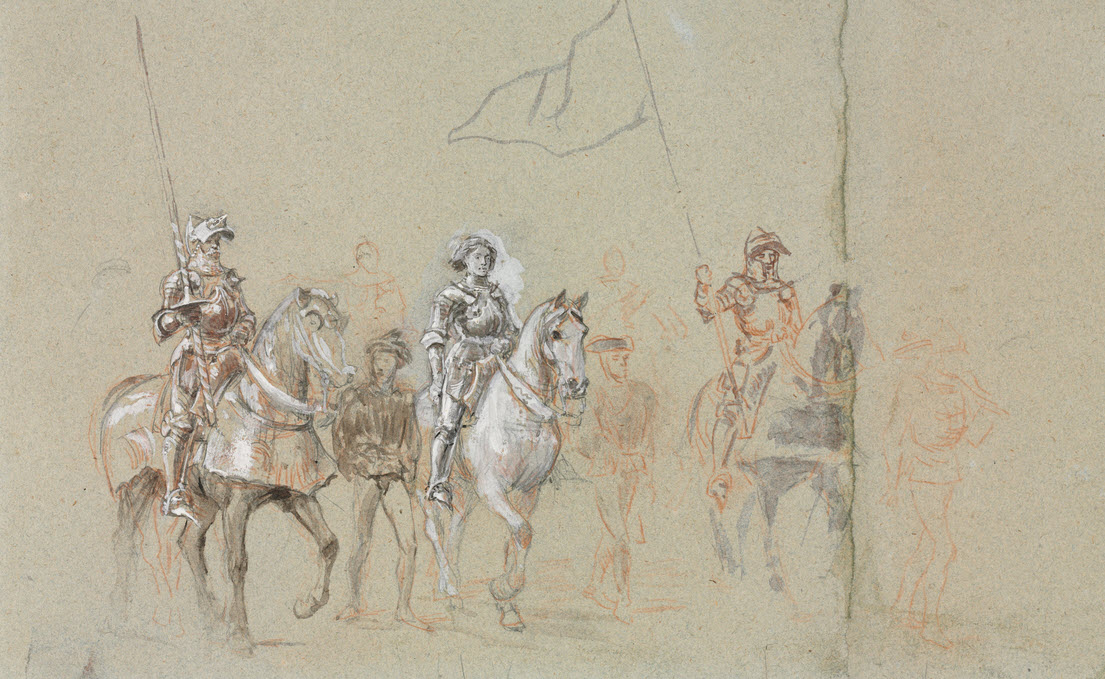
Joan of Arc, c. 1889. Ernest Meissonier (French, 1815-1891). This drawing is part of astudy for a planned, but never completed mural, featuring Joan of Arc in the Pantheon in Paris.
Joan of Arc
JOAN OF ARC, popularly known as the Maid of Orleans, was famous French heroine, born in the village of Domremy, now the department of the Vosges, France, Jan. 6, 1412; executed May 30, 1431 at Rouen, Normandy.
Joan of Arc descended from humble parents, secured a very rudimentary education, and learned to spin, sew, and do household duties. The protracted wars between France and England gave her much concern, and the woes of her country inspired her with an ardent desire to render patriotic service.
When thirteen years of age, she was impressed with a belief that she was divinely chosen to assist the French dauphin. After solitary meditation, she proceeded to interview the prince, and with pious enthusiasm persuaded those in authority to give credence to the heavenly vision and angelic voices that had led her to activity.
After donning male attire and equipping herself with a sword and a sacred banner, she proceeded with Count de Dunois to bring about the deliverance of Orleans. An army of 10,000 men was placed at her disposal, with which she marched from Blois and entered Orleans on April 29, 1429. Her superb leadership and numerous sallies animated and inspired the French with confidence, and, after successive and well-directed attacks, they forced Suffolk, the English commander, to abandon the siege of Orleans on May 8, 1429. Joan at once became the heroine of the French, and the dread of the English who attributed her victories to witchcraft. Numerous successes followed at Orleans, and shortly afterward she conducted Charles to Rheims, where he was anointed and crowned king, on July 17, Joan occupying a position of honor at his side.
It was the wish of Joan of Arc that she might return home after this coronation, but, after prolonged persuasions by Charles, she was induced to remain with the army. In the attack on Paris, where the troops were repulsed by Bedford, she received a slight wound, but continued aggressive action until May 25, 1430, when she was taken a prisoner by the Burgundian forces in Compiegne, and sold to the English.
The English took her to Rouen, in Normandy, which was then under English occupation, and subjected her to a prolonged and shameful trial, at the conclusion of which Joan was condemned to death as a sorceress. Shortly afterward the punishment was commuted to perpetual imprisonment, but the English found a pretext to treat her as a relapsed criminal and condemned her to be burned. This terrible fate she suffered May 30, 1431, and her ashes were thrown into the Seine River. A court was constituted by Pope Calixtus III. in 1455, which declared her innocent and pronounced her trial unjust. In French history she occupies a place of honor and in the history of civilization she ranks as a heroine and martyr, her memory being fittingly commemorated in statuary and literature.
This site is dedicated to the History and Culture of Beautiful Normandy France.



